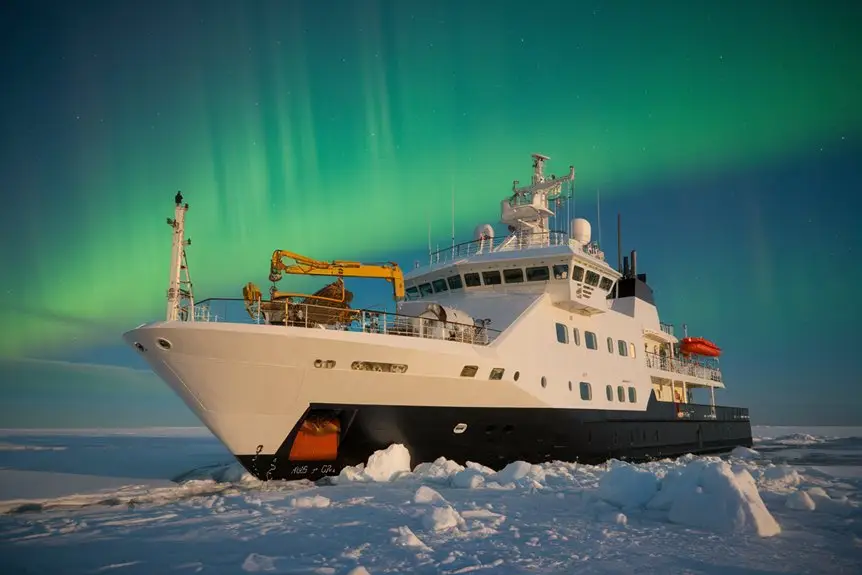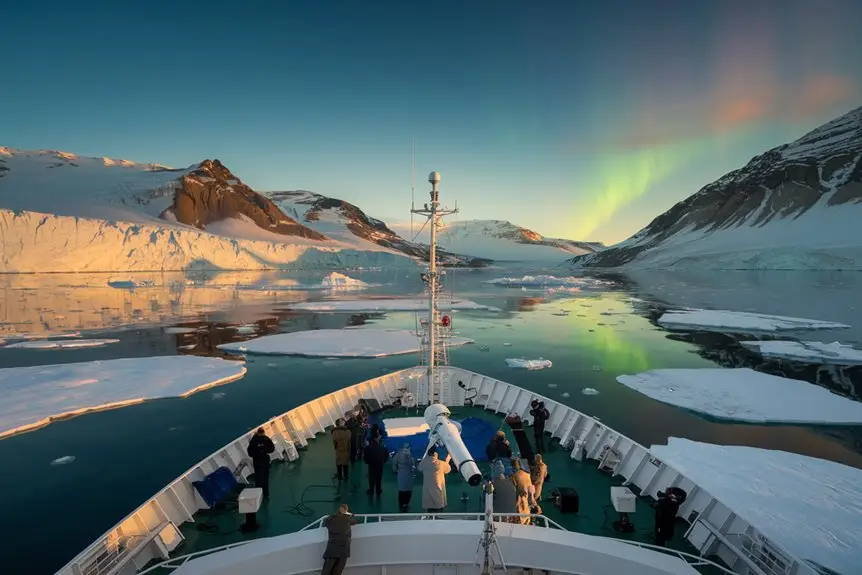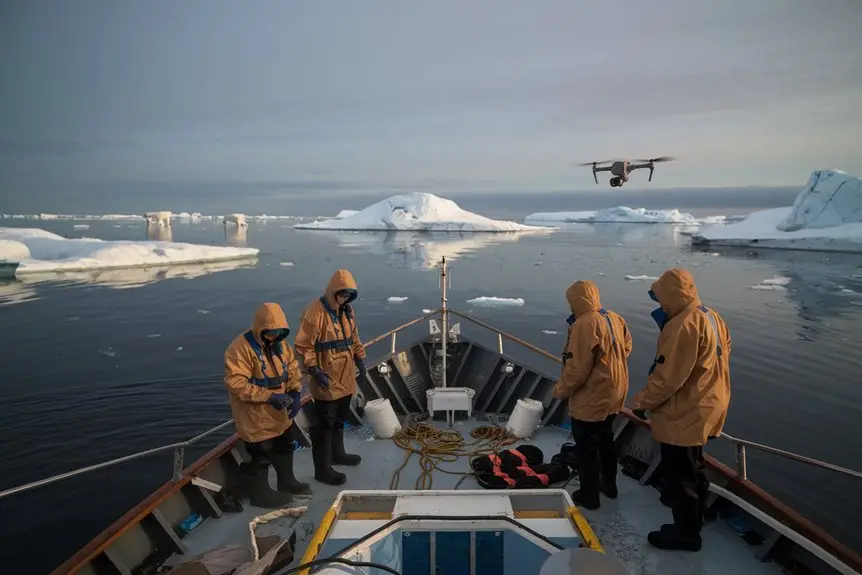Planning your polar research cruise takes specific preparation. These ships measure 100-115 metres long and feature ice-breaking capabilities and research laboratories. You can choose between destinations like Svalbard, the Antarctic Peninsula, Iceland or Greenland, with each location offering unique scientific opportunities.
You must comply with IMO Polar Code rules and pack crucial safety items. Your essential gear includes:
- Survival suits
- Communication devices
- Weather monitoring tools
Your daily activities will involve:
- Following weather updates
- Maintaining safe distances from wildlife
- Collecting data using structured methods
Understanding these requirements will help you make the most of your polar research journey. The vessels provide a safe, practical environment for your scientific work, letting you focus on your research goals while following necessary safety protocols.
🐧 Polar Cruise Enquiry 🐻❄️
Our team of polar travel specialists have personally explored both the Arctic and Antarctic regions – from tracking polar bears in Svalbard to kayaking with penguins off the Antarctic Peninsula. Let us find the right polar expedition cruise for you.
Key Takeaways
Research Vessel Basics
You’ll join 55-60 fellow scientists and crew members aboard these specialised ships. You can access 16 fully-equipped labs to conduct your polar research.
Research Locations
- Svalbard’s arctic waters
- The Antarctic Peninsula
- Iceland’s coastal regions
- Greenland’s unique ecosystems
Safety Requirements
- IMO Polar Code certification
- Complete polar safety equipment
- Daily safety briefings
- Regular lifeboat practice
- Weather monitoring systems
Research Guidelines
- Follow clear data collection methods
- Work with trained research guides
- Use digital tools to record:
- Wildlife sightings
- Ice conditions
- Environmental readings
- Distance from wildlife
Each location offers you research facilities and diverse ecosystems for your polar studies. You’ll maintain strict safety protocols whilst collecting valuable scientific data.
Polar Research Vessel Characteristics
Polar research vessels share key features that help them work in harsh polar environments.
You’ll find these ships measure 100-115 metres long and 22 metres wide. Their powerful twin electric motors deliver 11,000 HP each, letting them break through ice up to 1 metre thick.
The vessels house 55-60 crew and scientists comfortably. You can access 16 dedicated science labs onboard, plus extra space for portable laboratory containers.
The ships include a flight deck that supports large helicopters like the Super Puma for transport and research missions.
Your safety in polar conditions comes from the vessel’s PC2+ ice rating and ability to operate in temperatures down to -46°C.
The strengthened hull and specialised equipment protect both crew and scientific work in these extreme environments.
Selecting Your Research Destination
Popular polar research destinations await your exploration, each offering distinct scientific value.
Svalbard in Norway gives you direct Arctic ecosystem access, whilst the Antarctic Peninsula lets you study diverse wildlife populations.
Iceland and Greenland provide well-equipped research facilities in accessible Arctic locations.
You must check current travel restrictions before planning your expedition. The Russia-Ukraine conflict affects Arctic travel routes, and COVID-19 guidelines vary by region.
The Polar Code sets strict rules for your vessel’s environmental impact. You can join scheduled expedition ships for your research or work with local science centres.
Choose your destination by matching these factors:
- Your specific research objectives
- Available scientific bases
- Local support services
- Transport connections
- Seasonal access windows
Your research success depends on selecting a location that combines scientific relevance with practical support systems.
Many specialist tourism companies now support research activities, making remote locations more accessible for your work.
Required Equipment and Documentation
Your vessel requires:
- IMO Polar Code certification
- Ice navigation equipment
- Emergency response plans
- Waste management systems
Your safety gear must include:
- VHF radio units
- Flotation survival suits
- Carbon monoxide detectors
- Rifles (for trained staff only)
- First-aid kits
Your personal equipment needs:
- Waterproof outer shells
- Emergency food supplies
- Shelter equipment (bivvi bags)
- Thermal flasks for hot drinks
Your station support includes:
- Laboratory equipment
- Polar Cirkel Workboat
- Search and rescue equipment
You must check and maintain all equipment before departure.
UK polar regulations require you to keep documentation for each item. Your expedition leader will verify your equipment list matches safety requirements.
Pack spare batteries and backup supplies for critical items.
You’ll find most equipment at the research station, but your personal gear needs careful preparation before you travel.
Safety Protocols During Research Voyages
Basic safety equipment enables polar research, but clear protocols keep you safe. You must follow the IMO Polar Code and attend all safety briefings before your voyage starts.
You need to:
- Wear your assigned safety gear
- Follow crew instructions promptly
- Join all lifeboat drills
- Learn to use emergency equipment
- Monitor weather updates
- Keep in touch with your team and crew
Your daily safety duties include:
- Following environmental rules
- Keeping a safe distance from wildlife
- Using approved risk management steps
- Getting medical clearance before travel
- Staying alert to hazards
- Reporting safety concerns to staff
Medical staff stay on board throughout your voyage, but you should get a health check before departure. You can speak to the crew anytime about safety worries or questions.
Remember: Your safety depends on teamwork and clear communication. Watch out for yourself and others during your research activities.
Data Collection at Sea
Data collection at sea needs three main elements: clear protocols, trained guides and digital platforms. You can gather reliable data during polar cruises by focusing on simple measurements and clear observations.
Follow these steps for effective data collection:
- Take photos to document wildlife and environmental conditions
- Measure basic elements like snow depth and ice thickness
- Upload your findings to simple platforms like Happywhale
- Follow your expedition guide’s instructions
Digital tools like FjordPhyto and the Polar Citizen Science Collective make your data sharing easy and engaging. Your guides will check the quality of your observations.
Keep your collection methods simple to avoid overwhelming the expedition team.
Tips for success:
- Choose straightforward measurement techniques
- Document everything with clear photos
- Use reliable digital platforms
- Work with your guides’ expertise
The simpler you keep your data collection process, the more valuable your contribution becomes to polar research.
Frequently Asked Questions
Can Family Members Join Researchers During Polar Cruise Expeditions?
While research expeditions are restricted to scientists, you can experience polar regions with your family through specialised tourist cruises. These voyages offer educational activities, wildlife spotting and guided shore visits. Most cruise operators welcome children aged 12 and above, ensuring a safe and engaging experience for the whole family.
What Happens if Crucial Research Equipment Breaks During the Voyage?
You’ll follow three key steps if your research equipment breaks during the voyage:
- Use your backup equipment and alternative tools immediately to continue essential work
- Contact the ship’s technical team to assess and repair the damaged equipment
- Modify your research methods to work around any equipment limitations
If repairs aren’t possible, you can:
- Simplify your experimental procedures
- Focus on different research aspects that don’t require the broken equipment
- Document the situation to explain changes in your research plan
- Wait until the next port to seek repairs or replacements
Remember to always bring spare parts and backup tools for your most important equipment. This preparation helps you avoid major disruptions to your research schedule.
How Do Researchers Handle Seasickness While Collecting Data?
Managing seasickness during research at sea:
You can control seasickness by:
- Taking anti-nausea tablets before setting sail
- Positioning yourself in the middle of the ship where movement is less noticeable
- Keeping your eyes fixed on the horizon to help your balance
- Planning your key measurements for times when the sea is calmer
- Staying hydrated and eating light, plain foods
- Moving to open-air areas when you feel queasy
- Starting with shorter trips to build your sea legs
- Wearing acupressure wristbands as a natural remedy
These practical steps help you stay focused on your research tasks whilst keeping seasickness under control. Your body typically adjusts to ship movements within 24-48 hours.
Are There Opportunities to Collaborate With Other Scientists During Expeditions?
Research expeditions offer you multiple collaboration opportunities at sea. You can connect with scientists worldwide through dedicated platforms like Polar Collective. You can join ongoing research projects through the ship’s onboard laboratories and research stations. You can contribute to citizen science initiatives by collecting and sharing data with the global scientific community. Your participation helps expand scientific knowledge whilst building valuable professional networks in marine research.
Can Researchers Extend Their Stay if Weather Conditions Are Ideal?
You can extend your research stay during ideal weather conditions, but three key steps are needed:
- Contact ship logistics team for transport adjustments
- Check your supplies have sufficient coverage
- Submit a request to expedition leaders for approval
The entire process typically takes 24-48 hours, so you’ll want to plan ahead when favourable conditions appear. Remember to monitor your essential supplies carefully before committing to any extension.
🐧 Polar Cruise Enquiry 🐻❄️
Our team of polar travel specialists have personally explored both the Arctic and Antarctic regions – from tracking polar bears in Svalbard to kayaking with penguins off the Antarctic Peninsula. Let us find the right polar expedition cruise for you.







